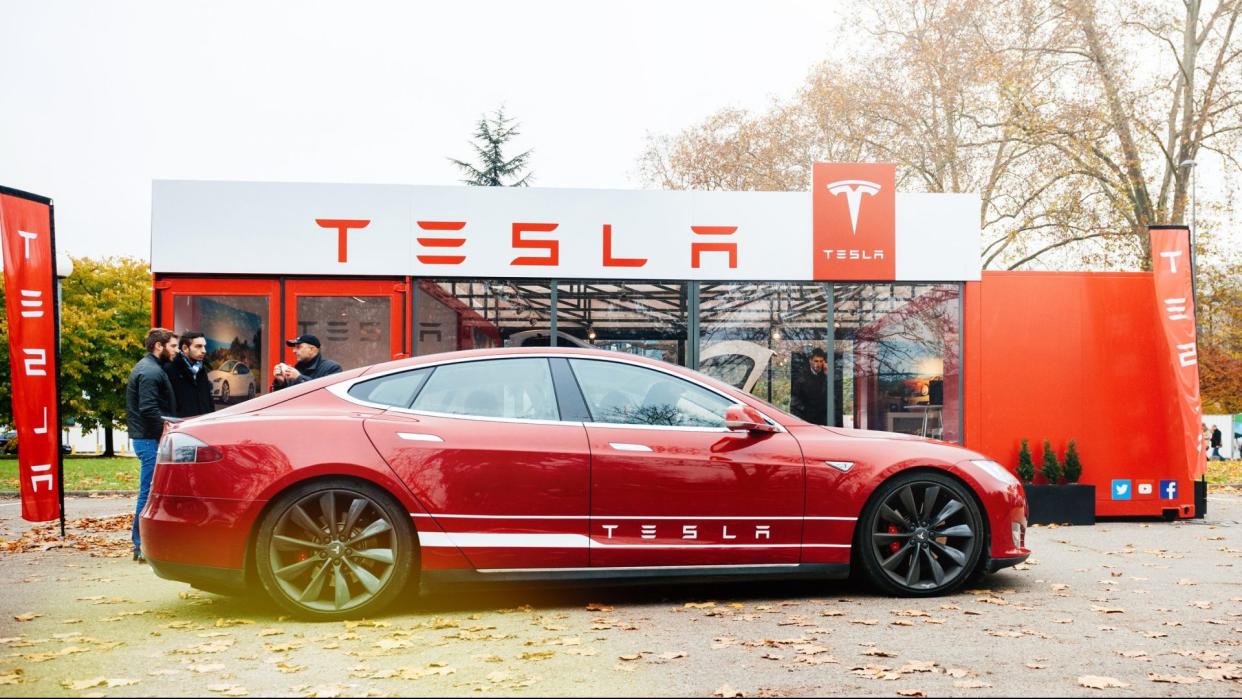Here’s How Much You’d Save on Gas With a Tesla and Other Electric Cars

Electric vehicles (EVs) are clean, green, and finally, in the mainstream. Compared to their gas-guzzling counterparts, they’re not cheap to buy — but MSRP isn’t everything. EVs have several ways of paying their owners back and then some over the course of their lives.
Read: Unplug These Appliances That Hike Up Your Electricity Bill
Important: This Credit Score Mistake Could Be Costing Millions of Americans
EVs Cost More — in the Beginning
If you’re considering an EV, you should budget much more than you would if you were buying something with a gas tank — or be prepared for some serious sticker shock. According to Electrek, the average price of a new EV soared to $66,000 in 2022. Although that’s a disappointing increase of 13% over the year before, the introduction of several very expensive high-end models dragged the average up.
It’s not just EVs that are getting more expensive. The Wall Street Journal reports that the average price of an internal combustion engine (ICE) vehicle jumped by 14% to $44,000.
However, according to Car and Driver, at least a half-dozen EVs cost less than $36,000, including the Nissan Leaf, which has a $28,495 starting MSRP.
Take Our Poll: Are You Struggling To Keep Up With Your Utility Bills?
But They Eventually Pay Their Owners Back
Not only are EVs more expensive to buy up front, but they cost more to own — but only in the first year or two. According to the Deepview True Cost Second Owner Study published by WePredict, here’s how EVs start paying dividends over ICE vehicles within three years:
Three months: Average EV service costs are $123 compared to $53 for ICE vehicles — EVs cost 132% more.
One year: Average EV service costs are $306 compared to $189 for ICE vehicles — EVs cost 62% more.
36 months: Average EV service costs are $514 compared to $749 for ICE vehicles — EVs cost 31% less.
So, if they’re that much more expensive to buy, how do EVs wind up becoming such a bargain over time?
First, the Obvious, Gas — or Lack Thereof
The national average cost of gas is nearly $3.80 a gallon, but even when gas was cheap, charging an EV was always a bargain compared to filling a gas tank. According to EnergySage, it costs $0.14 per mile to fuel an ICE vehicle compared to just $0.04 per mile to charge an EV.
Here’s a look at how that plays out in real life with comparable elecetric and gas cars, as laid out by CNET:
2022 Honda Accord Sport (ICE): $1,929 in fuel costs over 15,000 miles
2022 Kia EV6 Wind (EV): $605 in electricity costs over 15,000 miles
And here’s a look at two comparable trucks:
2022 Ford F-150 Lariat (ICE): $3,028 in fuel costs over 15,000 miles
2022 Ford F-150 Lightning XLT (EV): $1,011 in electricity costs over 15,000 miles
The Key is at-Home Charging
Fuel savings vary dramatically depending on the EV and the gas car you’re comparing it to, but one thing is consistent across the board — home charging is cheaper. Most of today’s EVs have sufficiently long ranges to allow their owners to do most of their charging at home. According to Consumer Reports, the “sweet spot” is 250 miles, which lets you do about 92% of your charging on the cheap at your house — that leaves only six stops at public charging stations per year.
According to the Energy Information Administration (EIA), the average American household pays about $0.15 per kWh for electricity. Presuming 1,183 miles driven per month, the typical EV would use 394 kWh at a cost of $59 per month, according to Kelley Blue Book (KBB), compared to $182 in gas for the typical ICE vehicle.
Also, There’s a Whole Lot Less That Can Go Wrong With EVs
The most obvious cost-of-ownership savings are in gasoline never purchased, but EVs are also much cheaper to maintain. According to the Drive Electric, the typical EV has only 20 moving parts compared to hundreds in an internal combustion engine.
The Deepview study revealed that the dramatic reduction in moving parts gives EVs a 22% lower average repair cost than ICE vehicles. The average EV owner spends $77 on maintenance in the first three years compared to $228 for gas vehicles.
Newer EVs Hold Their Value at Least as Well as Old-School Cars
Like combustion vehicles, EVs lose value over time. Also like traditional cars, not all EVs depreciate at the same rate. Variables like features, class, and manufacturer reputation determine how well both kinds of vehicles hold their value. That said, Consumer Reports found that “newer long-range EVs are holding their value as well as or better than their traditional gasoline-powered counterparts as most new models now can be relied on to travel more than 200 miles on a single full charge.”
Electric or gas, all cars are depreciating assets that begin losing value the moment you get behind the wheel — or are they? In 2019, Elon Musk insisted that — thanks to their self-driving capabilities — Teslas were becoming the first appreciating production vehicles in automotive history.
Time will tell.
More From GOBankingRates
This article originally appeared on GOBankingRates.com: Here’s How Much You’d Save on Gas With a Tesla and Other Electric Cars
